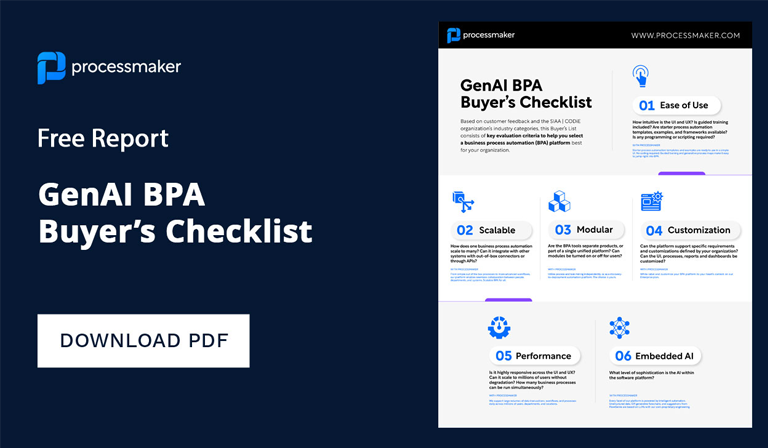El enfoque tradicional de la gestión de proveedores es muy manual, lento e ineficiente. En la era de la automatización, es fácil ver por qué la gestión manual de proveedores parece tan anticuada. Lo que antes era una cuestión de llevar la cuenta de tus proveedores en hojas de cálculo y en el correo electrónico se ha convertido en una oportunidad para mantener a todos tus proveedores en un solo lugar y gestionar sus datos sin pasar horas en el papeleo.
Con la automatización de los procesos digitales (DPA), una única fuente de datos significa que se acabaron los sistemas dispares. Se acabaron las conciliaciones. Se acabaron los correos electrónicos de ida y vuelta.
El proceso de gestión de proveedores proporciona un marco para las interacciones coherentes con los proveedores externos
Los proveedores son una parte fundamental del éxito empresarial. A menudo le ayudan a dirigir su negocio proporcionándole los productos o servicios que necesita para que todo vaya bien.
Pero si no se gestionan con atención, los proveedores también pueden provocar graves problemas. Por ejemplo, si los contratos con los proveedores están mal redactados o no se cumplen correctamente, pueden generar responsabilidad legal para su empresa e incluso perjudicar seriamente su flujo de caja. Y si no se dispone de un sistema para gestionar a los proveedores, es fácil que se pierdan comunicaciones esenciales -como las solicitudes de prórroga de los plazos de pago- o que se pierdan por completo los contratos con los proveedores.
Estos problemas pueden evitarse aprovechando el proceso de gestión de proveedores (VMP). El uso de este proceso proporciona un marco para las interacciones coherentes con los proveedores externos. Le ayuda a evitar el incumplimiento de los plazos, la interpretación errónea de los términos del contrato o la creación de otros problemas debido a prácticas de gestión incoherentes.
¿Cómo funciona la automatización de procesos digitales?
La automatización de procesos digitales (DPA) utiliza software para gestionar y optimizar sus procesos empresariales. La DPA puede funcionar de varias maneras y se ha demostrado que aumenta la productividad, reduce los gastos generales y mejora la rentabilidad de las empresas de todos los sectores.
Para entender cómo funciona la DPA, hay que empezar por lo que es. Las herramientas de DPA funcionan tomando las tareas de los empleados de forma manual y realizándolas automáticamente. Por ejemplo, si quieres actualizar la información de un cliente cuando se muda o cambia de número de teléfono, podrías introducir los nuevos datos manualmente en tu sistema. Este proceso lleva tiempo e introduce la posibilidad de un error humano.
Según el Informe WorkMarket In(Sight)el 78% de los líderes empresariales cree que la automatización aumenta la productividad de los empleados. Con las plataformas DPA, puede automatizar la gestión de proveedores. Por ejemplo, cuando recibe una notificación de que la información de un cliente ha cambiado, el software actualiza automáticamente los datos en su sistema para que todo esté al día.
La automatización de procesos digitales (DPA) puede ayudar a su organización a gestionar los proveedores de forma más eficaz y eficiente
Cuando se trata de gestionar proveedores, la automatización de procesos digitales (DPA) puede ayudar a su organización a hacerlo de forma más eficaz y eficiente.
Si usted es una empresa que trabaja con muchos proveedores o está pensando en aumentar el número de proveedores con los que trabaja, sabe que la gestión de proveedores puede descontrolarse rápidamente si no se dispone de un sistema sólido para gestionarlos.
Tradicionalmente, muchas empresas utilizan hojas de cálculo para hacer un seguimiento de la información importante, como los contratos y acuerdos con los proveedores, pero este método es propenso a los errores y difícil de actualizar. Las plataformas DPA permiten gestionar a los proveedores agilizando todos los datos y procesos asociados a ellos -incluyendo contratos, acuerdos, facturas, aprobaciones, órdenes de compra y facturación- en un sistema organizado.
También utiliza AI/ML, gestiona los conectores y automatiza las reglas empresariales. Esto se puede hacer mediante la creación de portales de proveedores potenciados por DPA que recogen automáticamente los datos necesarios para la gestión de proveedores y automatizan las numerosas tareas asociadas a la incorporación de nuevos proveedores.
También puede utilizar la tecnología de automatización de documentos inteligentes para crear contratos y acuerdos sin errores sobre la marcha. Con estos sistemas implantados, tendrá la seguridad de que sus procesos de gestión de proveedores son mucho más eficientes que antes, y podrá dar soporte a más proveedores si es necesario.
Además, una solución DPA también puede ayudar a su organización a mejorar la comunicación con los proveedores y a gestionar mejor todo el ciclo de vida de la relación con ellos. Esto puede aumentar la transparencia en toda la organización, reforzar los controles internos, facilitar la colaboración entre departamentos, reducir el riesgo, imponer el cumplimiento y, en última instancia, ayudar a impulsar resultados empresariales positivos.
La racionalización de los procesos de gestión de proveedores reduce los errores humanos y mejora la coherencia
¿Con cuántos proveedores trata su empresa? Si es como la mayoría de las empresas, la respuesta es muchos: recursos humanos, seguros, contabilidad, nóminas y otros. Y para cada uno de esos proveedores, tienes que gestionar la relación, desde el contacto inicial hasta la facturación y el pago.
En la gestión de proveedores, la coherencia y la responsabilidad lo son todo. DPA puede ayudarle a racionalizar sus procesos de gestión de proveedores, reduciendo los errores humanos y mejorando la coherencia.
- Reducción de los errores humanos: Nuestro software comprueba automáticamente la exactitud de cada orden de compra con respecto a las políticas de su empresa. Así se ahorra tiempo y se reducen las equivocaciones causadas por errores humanos o por una mala comunicación entre departamentos.
- Mayor coherencia: El uso de DPA significa que todos sus acuerdos con los proveedores están en un solo lugar y se actualizan regularmente para que nada se escape. Incluso puedes establecer alertas para fechas importantes, como la renovación de los contratos.
- Mejor visibilidad de los hábitos de gasto: Con DPA, todos tienen acceso a lo que se gasta donde más lo necesitan, ya sea durante una auditoría o simplemente porque quieren más información sobre el presupuesto de su departamento.
Permitir el análisis en tiempo real, la supervisión y la respuesta rápida a los problemas que surgen durante el proceso de gestión de proveedores
DPA se integra en muchos sistemas existentes con un esfuerzo mínimo y proporciona una solución integral para la gestión de proveedores, incluyendo:
- Registro de proveedores
- Calificación de los proveedores
- Incorporación y retirada de proveedores
- Rendimiento de los proveedores
- Mantenimiento de proveedores
El uso de DPA para la gestión de proveedores le proporciona las herramientas para gestionar todos los detalles de sus relaciones con los proveedores desde un panel de control fácil de usar, sin importar con cuántos proveedores esté trabajando en un momento dado.
Las plataformas de automatización de procesos pueden integrar sistemas internos y externos, agilizando aún más el proceso de gestión de proveedores
Un sistema centralizado de gestión de proveedores es clave para el éxito de su empresa. Para ayudarle a entender lo que queremos decir, hemos reunido algunos ejemplos rápidos de cómo DPA puede ayudarle a alcanzar sus objetivos:
- Integrar los sistemas internos y externos a través de las API, agilizando aún más el proceso de gestión de proveedores.
- Genere informes detallados sobre el rendimiento y el gasto de los proveedores, que pueden enviarse automáticamente a quien usted elija.
- Vea todos los proveedores y sus subproveedores asociados en un solo lugar, lo que le permite ver exactamente quién participa en sus proyectos en un momento dado.
Con la DPA, puede recurrir a proveedores ajenos a su empresa para ofrecer un mejor servicio a sus clientes.
Pensamiento final
Es hora de llevar la gestión de sus proveedores al siguiente nivel con DPA.
DPA puede ayudarle a gestionar mejor a sus proveedores:
- Mantenerlos todos en un solo lugar, para no tener que perder tiempo buscándolos.
- Seguimiento de las empresas que gastan qué y dónde, y con qué frecuencia.
- Garantizar que siempre se paga la cantidad correcta, a tiempo, sin investigaciones ni seguimientos.
- Ayudarle a controlar los costes y establecer un presupuesto.
- Le damos acceso a una asistencia 24/7 para que cuando algo vaya mal, alguien esté preparado para intervenir y ayudar.





